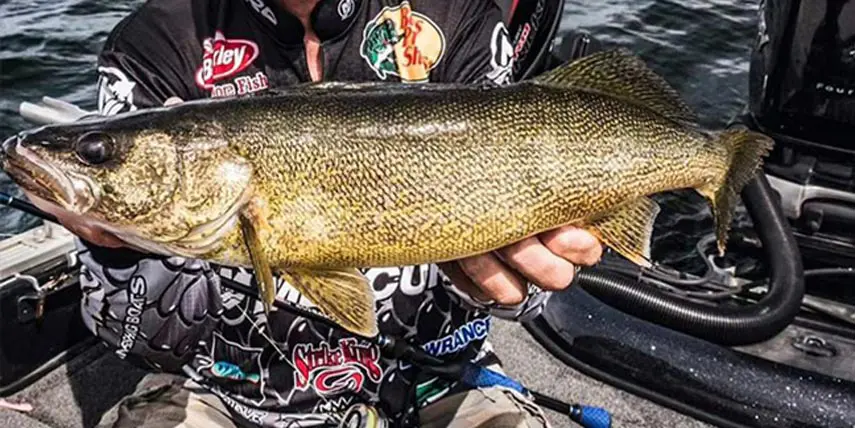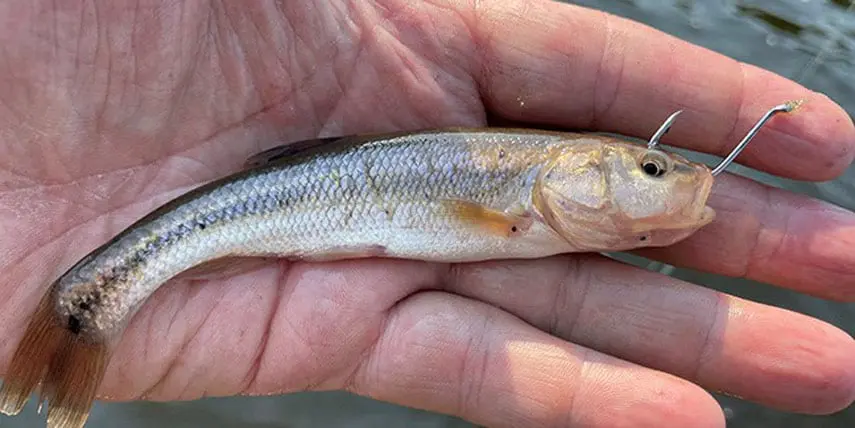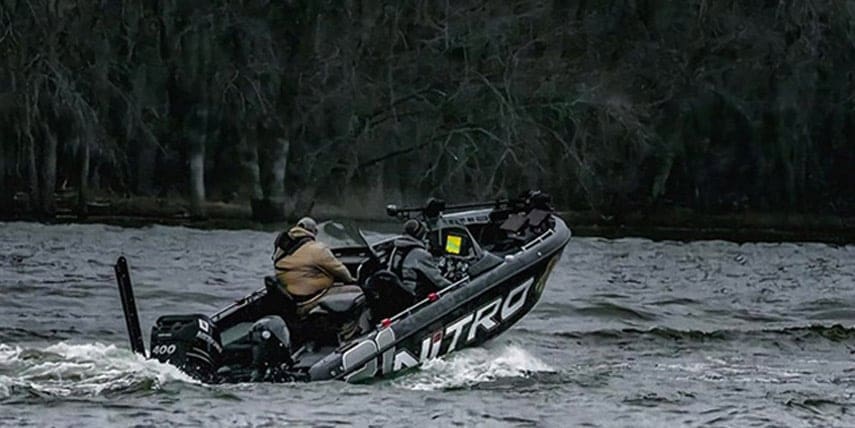Gary Parsons has been around the block long enough to know that sometimes you can’t beat live bait. “While glide baits, swimbaits, cranks, and lots of other artificial baits will certainly catch walleyes in a lot of situations, there are times—especially during fall—when nothing beats a giant creek chub for putting bigger walleyes in the net,” divulges Parsons. “Plus, it’s just a fun way to fish.”
Location, Location, Location
Post-turnover, walleyes can be anywhere, from a foot of water to over 40. Still, they will relate to points, humps, reefs, existing green weededges, and other structure that attracts food—minnows that have often grown large this late in the year, like tullibees (aka ciscoes) and other pelagic forage.
“On lakes around home in Wisconsin, I find a lot of fish in those 20-something depths. If the lakes don’t bottom out very deep, you will find them in 15 feet and shallower, but on some lakes, walleyes can be down in 45 feet or even deeper, like in Dakota reservoirs. It really depends on the body of water, especially after turnover,” continues Parsons.
He says that’s where today’s electronics come in, everything from standard 2D sonar to Side Imaging to forward-facing units.
“In fall, you really want to find stretches of shorelines, points, and sunken islands that are holding fish. Side Imaging and forward facing sonar works well because you can use it in tandem with 2D sonar to find fish so much faster than we used to. Then, once you’ve located them from a distance and set your waypoints, you’re ready to start fishing,” says Parsons.
Parsons has one caveat, though.
“But these technologies still aren’t to the point that you can really differentiate between schools of suckers and other rough fish—which are often in the same areas you’d expect walleyes. And sometimes the sucker schools can be large. So, if you’re an underwater camera guy, sink your Aqua-Vu or MarCum and look around; that’ll clue you in almost immediately if they’re the right fish.”

How To Fish Creek Chubs
“Fishing creek chubs isn’t rocket science,” notes Parsons, “but it does require some attention to detail, like not making your leader too long. It’s basically a live bait rig setup with an egg sinker, a 4- to 6-foot leader, and then I use a Berkley Fusion 19 Live Bait Hook, which are super sharp and strong.”
When it comes to minnows, most days Parsons prefers 4- and 8-inch creek chubs pinned to a 1/0 hook.
“And if I get giant creek chubs, those 10- to 12-inchers, I’ll size up to a 2/0, even a 3/0 hook to ensure the hook gap is bigger than the thick portion of the creek chub’s head.”
Parsons says proper hook gap is super important because walleyes tend to grab chubs head-first.
“Since bigger walleyes grab the bait head-first, when you set the hook, it’s harder for them to spit the chub without getting hooked,” continues Parsons.
“The cool thing about fishing big creek chubs is you can feel them trembling and struggling whenever a walleye comes close. Creek chubs don’t want to get killed, so they try to swim away. When they start shaking, I’ll let out 5 feet of line, and the swimming away will trigger even tentative walleyes to eat. A lot of times you don’t even have to free-line the chub. But I like to open the bail and let the bait swim away for a minute or two and then if I feel a bite, I’ll give them 10 or 15 seconds before I sweep the hook set. If you give them longer, you can hook them too far down the gullet, making releasing big fish tough,” notes Parsons.

While big walleyes tend to grab big creek chubs head-first, sometimes if the minnow is swimming away, they’ll attack from the side, which can cause problems with hooksets.
“If a walleye grabs a chub sideways, it’s pretty hard to get a good hookset, and you won’t know that until they fight you all the way back to the boat and then all of a sudden let go—and swim away. It can be frustrating when you’re fighting a 10- to 12-pound fish.”
But over the years I’ve learned a system to catch trophies again, even if they let go.
“Thing is, walleyes love creek chubs. So even if the fish had it sideways and just let go without hooking, you can tempt that fish as many as a few more times to eat the same bait again. So, what you need to do is let the chub back down and start pumping the rod up and down. Once I started doing this the percentages of re-hooking were unreal—almost 50% of the time, even after losing the fish on the initial fight. These fish will come back and grab the same bait they let go of again.”
Parsons won a PWT tournament doing just that.
“Honestly, it happened by mistake. My son Chase and I were fishing when he was really young, and we hooked a good fish on a piece of structure in 35 feet. As we fought the fish, we drifted out over 80 feet of water. The fish was probably 15 feet down and it was windy. Turns out the fish had grabbed the chub sideways and let go right at the boat. We were pre-fishing, so I really wanted to find out whether it was a big walleye or a pike. Chase was sitting there with his shoulders slumped, holding onto the rod, line just drifting back out, and the fish came back and smoked that chub again. He fought the fish, we netted it, and it measured 27 inches. That’s when the light bulb went off and we started fishing chubs differently—letting the bait back out again—pumping the rod and jigging—if we lost fish at boat-side.”
Gary and his son, Chase, ended up smoking that particular PWT tournament, taking top honors with this new creek chub system.
“Half the fish we had on in the tournament grabbed our chubs from the side and were letting go at boat-side, but we were able to let the line back out, kind of pump the rod and jig and get them back into biting.”
Apparently, a tournament videographer was in the Parsons’ boat and the footage reveals one particular 26-inch walleye that bit a creek chub five times before they finally sank metal into it and got it netted.

Parting Words
You might be asking: Where do I get creek chubs this fall?
Good question, because they can be hard to find, often fetching up to several dollars each when bait shops do have them—and they sell fast, especially during tournament time.
A better system? You got it: Go catch your own.
“We like to catch our own,” says Parsons, “Which is definitely part of the fun.”
Where to look for creek chubs? Most smaller streams connecting to larger rivers in Wisconsin, Minnesota, and the Dakotas have some kind of creek chub population. All you need is a tiny hook or ice fishing jig, a small piece of ‘crawler (or American cheese), and a split-shot to catch them. Light line on an ultra-light panfish rod and reel for tight spaces – or a fly rod – is perfect.
However, make sure to check your local and state laws regarding live bait transport and if you need to carry a cooler with your own well water to move them to walleye waters legally.
Dressing for Cold Conditions
Fall walleye fishing weather—especially on big water—can be completely unpredictable with frequent snow, rain, sleet, and wind—as well as sub-freezing temps.
One of the designers of the Whitewater Great Lakes suit, Parsons says he likes to wear it with a warm and water-repellant Whitewater sweatshirt and/or Whitewater Heated Vest underneath most October nights.
“As it gets later in the fall during November, then I’ll wear the Whitewater Softshell Tamer Jacket and Bib underneath the Whitewater Great Lakes Jacket and Bib, too. That guarantees I’ll be waterproof, windproof, and warm. And we designed all of the above with loads of stretch so it makes moving around the boat at night easier than a lot of the stiff rainsuits and foul weather apparel you see on the racks. It’s also not bulky, which is nice. Lots of free range of movement for playing fish standing up and netting fish, too.”
SIDEBAR: Another member of the chub family is the redtail. In some areas, like central and northern Minnesota, they are the preferred autumn walleye offering. Like creek chubs, redtails, too, can be found in clear running streams, most often ones draining into river systems like the Mississippi, and can be caught “micro fishing” with diminutive trout hooks adorned with crawler bits, even corn. If available at local bait dealers, they will set you back some dinero, but worth it.

